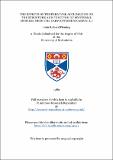Files in this item
The effects of temperature acclimation on the structure and function of myotomal muscles from the carp (Cyprimus carpio, L.)
Item metadata
| dc.contributor.advisor | Johnston, Ian A. | |
| dc.contributor.author | Fleming, John Richard | |
| dc.coverage.spatial | 180 p. | en_US |
| dc.date.accessioned | 2018-07-04T16:51:25Z | |
| dc.date.available | 2018-07-04T16:51:25Z | |
| dc.date.issued | 1989 | |
| dc.identifier.uri | https://hdl.handle.net/10023/14941 | |
| dc.description.abstract | Chapter One Introduction Research in the structure, biochemistry, electrophysiology and mechanical properties of fish muscle is reviewed. A variety of mechanisms underlying temperature acclimation and adaptation is described. Chapter Two The effects of temperature acclimation on muscle relaxation in the carp (Cvprinus carpio L.1 1. Common carp were acclimated to either 7 or 21 ° for a minimum of one month, and the twitch contraction kinetics of a nerve-muscle preparation investigated. 2. A significant compensation for the acute effects of a temperature change was achieved in twitch kinetics by acclimation to 8 °. An acute drop in temperature from 20 to 8 ° in 20 °-acclimated preparations led to approximately 2 and 3 fold increases in the half times for activation and relaxation. Chapter Three The effects of temperature acclimation on the pCa-tension relationship of slow myotomal muscle fibres from the carp 1. Common carp Cvprinus carpio L.) were acclimated to either 7 ° or 2 3 ° for at least one month. 2. The pCa-tension relationship of skinned slow fibres isolated from the anterior myotomes was investigated at pH 7.0, 7.6 and at 0 ° and 15 °. 3. Sigmoid pCa-tension curves were obtained with 'n' (i.e. Hill coefficient) values between 2 and 3. 4. Temperature acclimation did not alter the sensitivity of the contractile apparatus to calcium under any of the conditions of pH or temperature investigated. Chapter Four The role of thyroid hormones in temperature acclimation 1. Common carp (Cyprinus carpio L.) were acclimated to either 8 ° or 22 ° for at least one month. 2. One group of cold-acclimated fish were made hypothyroid by treatment with methimazole (80mg/100ml 0.9% NaCl) 0.5?g/g body weight once every two days. 3. The level of T3 and T4 in the plasma of carp was determined using a radioimmunoassay technique. 4. Frozen sections of m. hyohyoideus muscles were cut and stained for the activity of succinic dehydrogenase and alkali-stable myosin ATPase to determine the percentage cross-sectional area of different fibre types. 5. m. hyohyoideus muscles from cold-acclimated fish had a higher proportion of slow oxidative fibres and fast oxidative glycolytic fibres than similar muscles from warm-acclimated carp. 6. The ultrastructure of slow myotomal muscle was investigated by electron microscopy. The volume fraction of mitochondria was higher in fibres from cold- than warm-acclimated fish (P<0.01). The volume fraction of myofibrils decreased in the series cold-acclimated > warm-acclimated > cold-acclimated, hypothyroid (P<0.01). The mean cross sectional area of individual myofibrils decreased in the series, warm-acclimated > cold-acclimated > cold-acclimated hypothyroid. 7. Hypothyroidism did not affect the total volume fraction of mitochondria in cold-acclimated fish. The volume fraction of mitochondria in the intermyofibrillar zone was higher in cold-acclimated euthyroid than hypothyroid fish (P<0.001). 8. Neither temperature acclimation nor hypothyroidism affected the volume or surface density of cristae within mitochondria. 9. The effects of temperature acclimation and hypothyroidism on the performance, composition and ultrastructure of muscle are compared and the involvement of thyroid hormones in temperature acclimation is discussed. Chapter Five General Discussion The results presented in this report are discussed in the context of providing mechanisms that may compensate for the effects of low temperature on the rate of diffusion of small molecules through the cytosol. | en_US |
| dc.language.iso | en | en_US |
| dc.publisher | University of St Andrews | |
| dc.subject.lcc | QL638.C94F6 | en |
| dc.subject.lcsh | Cyprinidae | en |
| dc.title | The effects of temperature acclimation on the structure and function of myotomal muscles from the carp (Cyprimus carpio, L.) | en_US |
| dc.type | Thesis | en_US |
| dc.type.qualificationlevel | Doctoral | en_US |
| dc.type.qualificationname | PhD Doctor of Philosophy | en_US |
| dc.publisher.institution | The University of St Andrews | en_US |
This item appears in the following Collection(s)
Items in the St Andrews Research Repository are protected by copyright, with all rights reserved, unless otherwise indicated.

